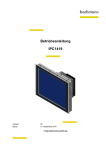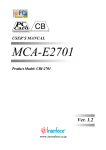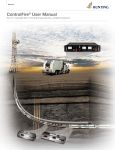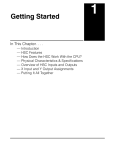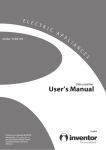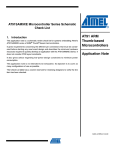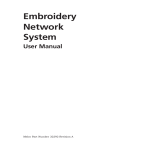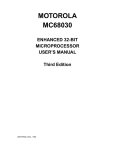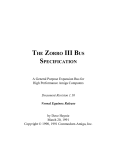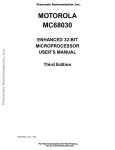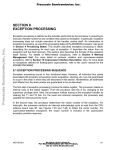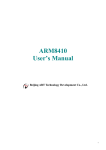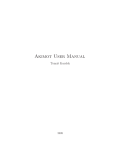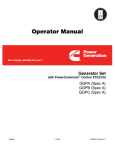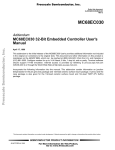Download Fat Buster II - thule.no Coming Soon!
Transcript
Integrated Circuit Specification for the Fat Buster II Expansion Bus Controller CSG 4145 - 013 by Dave Haynie Copyright ©1991 Commodore Technolgy Group Information contained herein is the unpublished, confidential and trade secret property of Commodore International Services Corporation, Technology Group. Use, reproduction or disclosure of this information without the prior explicit written permission of Commodore is strictly prohibited. 1.1 General Description This specification describes the requirements for Fat Buster II, a Bus Controller Integrated Circuit (I.C.) designed to provide a high speed expansion bus for 68030 based Amiga computers that meets the specifications for the Zorro III Expansion Bus (see The Zorro III Expansion Bus Specification for more information on the particular bus protocols described here). The Buster chip performs two main functions in an Amiga system. It acts as a bus protocol converter, translating 68030 cycles into Zorro II or Zorro III cycles, and Zorro II or Zorro III cycles into 68030 cycles, as appropriate for a particular bus cycle. In addition, it acts as the bus arbiter for bus requests originating on the Amiga local bus, or on the expansion bus according to Zorro II or Zorro III protocols. The particular list of features is as follows: • 68030 to Zorro II cycle conversion with proper synchronization. It supports cache mapping of Zorro II space, "sloppy cycle" bus snooping, and Zorro II standard bus lock conversion. • 68030 to Zorro III cycle conversion, including 68030 burst to Zorro III multiple cycle translation and quick interrupt cycle types. • Zorro II and Zorro III to 68030 cycle conversion. • PIC collision detection for Zorro II and Zorro III. • Buffer control to support external data and address buffers necessary for Zorro II and Zorro III bus operation, including a bridging buffer for funneling Zorro II DMA cycles to either half of a 32-bit 68030 local bus. • Time-multiplexed bus request for sharing with an alternate high-speed local bus master. • One local bus 68030-protocol DMA channel. • Five expansion bus Zorro II/Zorro III protocol DMA channels, with fair arbitration within channel groups. • Eight cycle Zorro III scheduling atom with LOCK* override and Zorro III grant timeout. 1.2 Theory Of Operation A block diagram of the Fat Buster II chip is illustrated below. As mentioned, the operation of this chip can be cleanly divided into two main groups: bus conversion and bus arbitration. In the case of bus conversion, there are four types of conversion. The 68030 cycle may be converted into Zorro II or Zorro III cycles, and the Zorro II or Zorro III cycle may be converted to a 68030 cycle. The cycle type selector looks at the output of the cycle type selector to determine which of the conversions to run. The type selector in turn looks at the output of the primary bus arbiter, to determine the direction of conversion, some Zorro bus and control information and externally generated chip selects to determine the conversion protocol. 1.2.1 Bus Conversions As mentioned, the Buster chip supports four types of bus conversions: 68030 to Zorro II, 68030 to Zorro III, Zorro II to 68030, and Zorro III to 68030. In all cases, the Buster chip provides just the basic logic to perform the conversion. Address mapping and the proper data buffer arrangement are also very critical to this process. The actual system requirements will determine the exact details of the external buffer and chip select design. 1.2.1.1 68030 to Zorro II Bus Conversion The most common conversion mechanism is 68030 to Zorro II bus conversion. This conversion begins after the address buffers are enabled, 68030 bus is the bus master, AS* is asserted, WAIT* is negated, and either MEMZ2* or IOZ2* chip selects are asserted to Buster. A start condition, internally defined based on this and the output of the sloppy cycle snooping logic, is synchronized by the falling edge of the CDAC clock and the rising edge of the C7M clock, to create the Zorro II compatible cycle strobe, CCS*. The appropriate data strobes and data buffer enables follow this according to Zorro II protocols. The DTACK* signal is sampled on the falling edge of the C7M clock, followed by the rising edge of the CDAC clock, beginning 1.5 C7M cycles after CCS* is asserted. On the next falling edge of C7M after DTACK* is recognized, the CCS* strobe is negated and the DSACK1* line to the 68030 bus is asserted. If the 68030 RMC* line is asserted at the end of the a cycle, Buster won’t drop CCS*, but will start the next cycle, which must be a Zorro II cycle, when called for by the next AS*, keeping CCS* low through the intercycle time. Buster also provides DTACK* generation on the expansion bus during Zorro II cycles. DTACK* is normally driven off the falling edge of the CDAC* clock following the assertion of CCS*. Assertion of the either the MTCR* line or the CACHE* line from the expansion bus keeps DTACK* high. Zorro II support also includes what’s known as sloppy cycle snooping. The Buster device monitors DTACK*, MTCR*, CACHE*, and the SLAVEN* lines, and will prevent any new cycle from starting until all of these lines have been negated. This prevents slow Zorro II devices from interfering with the operation of the next cycle. 1.2.1.2 68030 to Zorro III Bus Conversion The 68030 to Zorro III conversion begins with the address buffers enabled, the 68030 bus as bus master. AS* asserted, WAIT* negated, and the ADDRZ3* chip select asserted. The Zorro III cycle begins with FCS* asserted from the CLK90 rising edge. Address buffer enables are negated on the next CPUCLK falling edge. Data buffers are enabled on the following CPUCLK rising edge, and data strobes on the next CLK90 rising edge. After this, DTACK* is sampled on the rising edge of CLK90, which in turn generates an STERM* for the 68030 bus. There are two basic variations to this cycle. If the 68030 requests a burst transfer, Buster will accept an MTACK* request from the Zorro III bus. Upon receipt of this strobe, a burst transfer will take place. MTCR* is driven for each subcycle, while the low order addresses A3-A2 are incremented appropriately. The other subcycle type is the interrupt cycle. A 68030 interrupt acknowledge cycle is translated into a Zorro III interrupt acknowledge cycle. On the second rising edge of CLK90 following the assertion of FCS* and MTCR*, Buster will latch the state of the SLAVEN* lines and negate MTCR*. If one or more is asserted, a priority encoder selects one, which indicates which board wins the right to supply the interrupt vector for this cycle. The MTCR* strobe is again asserted, along with the selected SLAVEN* line and the low order data strobe. The rest of the cycle concludes as a normal Zorro III cycle. 1.2.1.3 Zorro II to 68030 Bus Conversion When a Zorro II device has the expansion bus, it may be necessary for Buster to convert Zorro II cycles into 68030 bus cycles. When a cycle begins that’s not detected as being in Zorro II space (eg, either MEMZ2* or IOZ2* are asserted), it must be converted to a 68030 cycle. This is started by sampling CCS* and the data strobes with the CLK90 clock. If its a read cycle, things can begin based on CCS*, if a write, the cycle on the 68030 bus can’t start until the data strobes are asserted. Once the appropriate Zorro II signals are latched, the 68030 cycle begins with AS* and DS* asserted. The A1 line is used to determine which half of the 32-bit bus is of interest during a read, while both halves are written during a write cycle. The conversion logic waits for a 68030 bus termination signal, which is assumed to indicate a 32-bit port. If it is in fact a 32-bit port, this termination becomes DTACK* on the Zorro II bus. If it is actually a 16-bit port and A1 indicates the lower half of the 32-bit bus, extra time is inserted while the "bus bridge" buffers, carrying expansion data to D15-D0, are turned off and the D31-D16 buffers are turned on. The cycle is then terminated as for the 32-bit port. This part does not support Zorro II DMA cycles to an 8-bit 68030 bus port. 1.2.1.4 Zorro III to 68030 Bus Conversion As with the Zorro II bus masters, a Zorro III bus master is likely to access 68030 resources, so a cycle conversion must be performed. When a cycle begins that’s not detected as being in Zorro III space (eg, ADDRZ3* is asserted), it must be converted to a 68030 cycle. This is started by sampling FCS* and then the Zorro III data strobes. It is assumed that, in any system requiring Zorro III DMA access to 68030 resources, that the external address buffers will latch DMA addresses on FCS*. Once FCS* and at least one data strobe has been sampled, the 68030 cycle begins with AS* and DS* asserted. Since the Zorro III bus is a fixed-width 32-bit bus, there’s a direct connection between it and the 68030 bus at this time, and only 32-bit ports on the 68030 bus may be addressed. The asynchronous termination signals are sampled on the falling edge of CPUCLK, while the synchronous termination signal is sample on the rising edge of CPUCLK. The output of both samplings is sent to a final stage and gated out to the Zorro III bus as DTACK* on the next CPUCLK falling edge. Note that Zorro DMA into 68030 space is the one case in this design where the external geographic mapping of resources isn’t strict. All Zorro bus cycles are typed by address space alone. However, DMA onto the 68030 bus is typed according to which of the cycle strobes is asserted by the bus master. In fact, the same 68030 bus resource can be seen as a 16-bit resource by a Zorro II master and a 32-bit resource by a Zorro III master. 1.2.2 Bus Arbitration The bus arbiter section of Buster is completely self-contained. There are two kinds of expansion bus requests, Zorro II and Zorro III requests. These enter the Buster device on the EBRN lines. The difference between Zorro II and Zorro III style requests are in the data format; a Zorro II request asserts EBRN until after a corresponding EBGN is returned, while a Zorro III request sends a 140ns pulse on EBRN. The first stage of the expansion bus arbiter logically separates Zorro II from Zorro III requests. Buster also manages requests from the local 68030 bus. These local requests, plus group requests from both Zorro II and Zorro III, are managed by a subsystem called the primary bus arbiter. 1.2.2.1 Zorro II Arbitration A Zorro II bus request is handled by the Zorro II slot arbiter subsystem in Buster. Incoming Zorro II requests are grouped and passed on to the primary arbiter. When the primary arbiter decides to honor any Zorro II request, it passes a group grant back to the Zorro II arbiter. Once it receives its group grant, this arbiter selects one grant to pass back to a Zorro II device. This selection process is based on a priority encoder similar to that used for Zorro II arbitration in the original Buster for the A2000. One addition is a fairness flip-flop for each channel. This ensures that once a channel has been granted bus access, it doesn’t get access again until all other pending requests are serviced. The Zorro II request and grant protocol is directly based on the 68000 bus arbitration protocol. Original Zorro II bus masters indicated bus ownership by asserting both OWN* and EBGACK*, with timing designed to minimize the chance of bus contention. Since the Buster chip now controls the bus buffers in a more complex manner, it uses the presence of either of these signals to hold the bus for Zorro II. Various Buster details assume that Buster-based systems will still use OWN* as the basis for address buffer direction control. 1.2.2.2 Zorro III Arbitration A Zorro III bus request is handled by the Zorro III slot arbiter subsystem in Buster. An incoming Zorro III request pulse will toggle the state of the registry flip-flop for that channel. This serves to generate new requests for unregistered channels and to terminate requests for registered channels. This arbiter groups the set of registered channels into a group request which is passed to the primary arbiter. When the primary arbiter decides to honor any Zorro III request, it passes back a group grant to this arbiter. Zorro III devices follow a request/grant protocol much different than that used in traditional 680x0 systems. The incoming "request" is really a request for registry. A registered master will be scheduled for bus cycles as they become available, but there’s no defined relationship between request for registery and grant. The Zorro III arbiter waits for a defined arbitration confition before rescheduling a Zorro III master. The first Zorro III master registered will force the arbitration condition, while subsequent registered masters will be scheduled in at the next arbitration point. At arbitration time, the arbiter considers all registered masters that don’t have their fairness flip-flop set. These are each passed through a priority encoder, which results in the selection of one device to master the bus. The arbiter next asserts a grant signal to the chosen master. It has a short time (several microseconds) to master the bus. If the bus isn’t mastered in the given time, a timeout condition is signalled, causing the grant to be negated and the master unregistered. Assuming the master takes the bus, it is allocated up to eight full cycles on the bus before the next arbitration condition. The first cycle run by the master will set its fairness flip-flop to the "used" condition. Assertion of the LOCK* signal to Buster will prevent rearbitration indefinitely. Once the current master starts its last cycle, Buster will negate its grant a prepare to schedule the next master. Assuming there is at least one registered master in the unused state, the first of those masters will be granted the bus once the current master completes its cycle. If there are no unused masters left, all the fairness flip-flops are cleared and the arbitration selects from the full set. Once no devices are registered, the Zorro III arbiter withdraws its group request from the primary arbiter. Zorro III masters have no need to deal with the OWN* or EBGACK* signals, so these are driven by the Buster logic during Zorro III DMA. EBGACK* generally serves no purpose other than to inform other bus masters that some device other than the default 68030 bus device is mastering the expansion bus. On the other hand, the OWN* signal is generally used by external address buffers as a direction indicator. 1.2.2.3 The Primary Arbiter The Buster device assumes that there is a default bus master on the 68030 bus, as there always is in the case of a real 68030 system. This master has primary control of the 68030 bus, and must honor a bus request via BR* before any alternate master can take over. The job of the primary arbiter is to deal with taking the 68030 bus in response to the various levels of request. Especially in the case of expansion bus requests, since neither expansion bus protocol has or should have special knowledge of how the 68030 bus operates. The primary bus arbiter deals with three main sources of request; the Zorro II group request, the Zorro III group request, and the 68030-style channel (SBR*/SBG*), in increasing order of priority. Any of these requests starts up a subsection called the bus request arbiter. Buster time-multiplexes the external BR* line to allow an alternate 68030 bus master to grab the bus very quickly, without having to go through the normal Buster priority channeling. Buster will only sample and drive this lin e on the rising edge of CPUCLK. Its expect that the external device only sample and drive this line on the falling edge of CPUCLK. In this way, if it detects BR* negated as CPUCLK rises, Buster asserted BR* and assumes the grant coming back from the default master is intended for it. If it detects BR* already asserted, Buster waits for BR* negated before driving it out. The grant once received, Buster selects between the 68030 channel and the two group channels, according to the aforementioned priority order. If the 68030 channel wins, Buster simply echoes the state of BG* onto SBG*, since this device knows the 68030 bus acquisiton protocol. If the request is instead from either Zorro II or Zorro III groups, the primary arbiter will master the 68030 bus itself, by asserting BGACK* and negating BR* in response to BG*. Once BGACK* is properly asserted, it will return a group grant to the winner of the primary arbitration. The bus grabbing mechanism holds the 68030 bus automatically as long as there’s a pending grant or a master still granted the expansion bus. 1.3 Pin Configuration Pin Name 1 2 3 4 5 6 7 8 9 10 11 12 13 14 15 16 17 18 19 20 FCS* CCS* A2 A1 A0 RW SIZ0 SIZ1 AS* DS* DSACK0* DSACK1* STERM* GND RMC* SBR* SBG* CIIN* MTACK* DTACK* Type Pin Name io io io io io io io io io o i io io g io i o io io io 21 22 23 24 25 26 27 28 29 30 31 32 33 34 35 36 37 38 39 40 DOE WAIT* BR* BG* BGACK* HLT* BERR* GND RESET* CPUCLK C7M CDAC* D2P* DBOE1* DBOE0* DBR16* DBLT READ EDS2* EDS3* Type io i io o io i o g i i i i o o o o o io io io Pin Name 41 42 43 44 45 46 47 48 49 50 51 52 53 54 55 56 57 58 59 60 61 62 63 64 65 66 67 68 69 70 71 72 73 74 75 76 77 78 79 80 81 82 83 84 LOCK*/EA1 VCC ABOE2* ABOE0* MS2 MTCR* CINH* A3 CBREQ* CBACK* IOZ2* MEMZ2* ADDRZ3* MS1 OWN* GND EBGACK* CLK90 SLAVE4* EA2 EA3 EDS0* EBCLR* SLAVE3* SLAVE2* SLAVE1* SLAVE0* BIGZ* EBG4* GND EBG3* EBG2* EBG1* EBG0* ABOE1* EBR4* EBR3* EBR2* EBR1* EBR0* MS0 BINT* EDS1* VCC Type io p o o i io io io i o i i i i io g io i io io io io o io io io io o o g o o o o o i i i i i i io io p 2.0 Signal Description The various Buster signals are described here, based on their functional categories. For more details on the 68030 signals, consult The MC68030 User’s Manual, from Motorola. For more details on the Zorro II-equivalent signals, consult A500/A2000 Technical Reference Manual, from Commodore-Amiga, and The MC68000 User’s Manual, from Motorola. For more details on the Zorro III signals, consult The Zorro III Bus Specification, from Commodore. 2.1 Power Group This section covers signals related to chip power supply. For more information on power supply in general, see the ratings section of this document. 2.1.1 Power (Vcc) The Buster chip is supplied by two power pins. It requires these to be at 5V DC, ±5%, throughout its operating range. 2.1.1 Ground (GND) The Buster chip’s ground return is on four ground pins. 2.2 Clock Group The Buster chip’s internal event timing is governed by various clocks, supplied to it by the system. 2.2.1 High Speed Clocks (CPUCLK, CLK90) The CPUCLK is the main clock used by Buster for all of its synchronous event timing. This is the same clock used to drive the 68030 events on the 68030 bus interface. It can be from 16MHz to 25MHz. The CLK90 clock is a secondary basis clock for Buster. This is essentially the main CPUCLK delayed by at least 10ns from either edge of CPUCLK. 2.2.2 Video-Derived Clocks (C7M, CDAC) The C7M clock, derived from the 28MHz video basis clock on most Amiga systems, is the basis clock for Zorro II cycles, which should be between 7.09MHz and 7.16MHz. This clock is also used as the basis for sampling bus registry pulses in Zorrro III bus arbitration. The CDAC clock is equivalent to the C7M clock delayed by 90°. It is used by the Zorro II state logic and as a synchronization clock for 68030 bus access to Zorro II. 2.3 Chip Select Group The operation of the Buster chip as a bus cycle converter is triggered mainly by various chip selects. Buster will stay quiescent until at most one of the three selects has been asserted by system logic. 2.3.1 Zorro II Memory Select (MEMZ2*) When the 68030 bus is bus master, MEMZ2* asserted causes Buster to run a cachable 68030 to Zorro II conversion cycle. During this cycle the CIIN* line on the 68030 bus will be negated, and all read cycles translate into 16-bit (eg, full port) reads, to support caching on the 68030 bus. When a Zorro II device is bus master, MEMZ2* asserted will prevent Buster from performing a Zorro II to 68030 bus conversion. 2.3.2 Zorro II I/O Select (IOZ2*) When the 68030 bus is bus master, IOZ2* asserted causes Buster to run a non-cachable 68030 to Zorro II conversion cycle. During this cycle the CIIN* line on the 68030 bus will be asserted, and all read or write cycles are sized as specified by the 68030 bus (eg, A1, A0, SIZ1, and SIZ0). When a Zorro II device is bus master, IOZ2* asserted will prevent Buster from performing a Zorro II to 68030 bus conversion. 2.3.3 Zorro III Select (ADDRZ3*) When the 68030 bus is bus master, ADDRZ3* asserted causes Buster to run a 68030 to Zorro III conversion cycle. Caching during Zorro III is of course achieved by translating the state of the Zorro III CINH* line to the 68030 CIIN* line. When a Zorro III device is bus master, ADDRZ3* asserted will prevent Buster from performing a Zorro III to 68030 bus conversion. 2.4 Buffer Control Group This group is responsible for the control of the data and address bus buffers that sit between the expansion bus and the 68030 bus. 2.4.1 Address Buffer Enables (ABOEN*) There are three address buffer control signals: ABOE2*, ABOE1*, and ABOE0*. The first of these, ABOE2*, is only used during Zorro III cycles. It is asserted to connect A31-A24 of the 68030 bus to AD31-AD24 of the Zorro III bus. This signal is only active during the address phase of a 68030 to Zorro III translation, or during the entire cycle for a Zorro III to 68030 translation (the Buster chip expects external logic to properly latch the Zorro III address in this case). The next of these strobes, ABOE1*, is asserted to connect A23-A8 of the 68030 bus to AD23-AD8 of the Zorro III bus. This signal is active during the address phase of a 68030 to Zorro III translation, or during the entire cycle for a 68030 to Zorro II or any Zorro to 68030 translation. In the case of Zorro III to 68030 translation, the Buster chip expects external logic to properly latch the Zorro III address such that it’ll remain valid throughout the 68030 cycle. The final address buffer control strobe is ABOE0*. It is asserted to connect A7-A4 and any other address-time signals (like the FC2-FC0 lines) between the 68030 and the Zorro bus. This is active throughout any cycle in which some kind of bus to bus translation is taking place. 2.4.2 Data Buffer Enables (DBOEN*) The DBOE1* line is active for all 68030 to Zorro transactions. It becomes active at data time for Zorro III, at approximately state S3 for Zorro II. It intends to bridge 68030 D31-D24 over to Zorro III AD31-AD24 and 68030 D23-D16 over to Zorro III ED7-ED0. Logically speaking, that connects the high-order half of the 68030 bus to the high order half of the Zorro III bus. Based on bus sizing rules for the 68030 bus, this also effectively bridges the correct half of the 68030 bus over to the Zorro II bus. The Buster chip expects that, for reads to the Zorro II bus, data will be latched externally (see DBLT for more details). This buffer is also active for Zorro III to 68030 conversions, Zorro II to 68030 writes, and Zorro II to 68030 reads with A1 = 0 (see DBR16 for more information on the bridge function). The DBOE0* line is asserted at Zorro III data time for 68030 to Zorro III translations and for Zorro III to 68030 translations. It bridges the low order 68030 data bus, D15-D0, to the low order Zorro III data bus, AD23-AD8. 2.4.3 Data Bridge Enable (DBR16*) This line, DBR16*, is used only for Zorro II to 68030 translations. When the 16-bit Zorro II bus master needs to access the lower half of the 32-bit 68030 bus, this signal is active. It is intended to drive a buffer bridge between 68030 data bus D15-D0 and the Zorro II data bus (given by AD31-AD24 and ED7-ED0 in Zorro III terminology). Bridging occurs when A1=1 on reads, and is always preformed during writes. If a Zorro II device accesses a 16-bit port on the 68030 bus, the size isn’t known until DSACK* time. In these cases, DBR16* may assert and then be negated, followed by DBOE1* being asserted, as the DSACK* lines indicate a 16-bit port responding. 2.4.4 Data Buffer Direction (D2P*) This signal is the direction indicator for any data buffer activity. When asserted, data flows from Zorro bus to 68030 bus. When negated, data flows from 68030 bus to Zorro bus. 2.4.5 Address Extension Enable (BIGZ*) This signal is asserted by Buster during a Zorro II to 68030 translation. It indicates to external logic that a high order address, A31-A24, needs to be provided on the 68030 bus by some kind of external logic. That address is usually $00. 2.5 68030 Bus Control Group The signals in this group are the basic 68030 bus control signals. They are driven according to all 68030 timing rules. Most are bidirectional, being one direction when the 68030 bus is master, and the other when the Buster chip is translating the cycles of a Zorro bus master. 2.5.1 Cycle Strobes (AS*, DS*) The AS* and DS* strobes define the basic 68030 cycle. When the 68030 bus is master, AS* is driven by the bus master into Buster. All 68030 to Zorro cycle translations start referenced to AS*. When the Zorro bus is master and accessing the 68030 bus as its slave, AS* and DS* are driven out by Buster, based on either FCS* or CCS* and the appropriate EDSN* lines. 2.5.2 Address Bus (A3-A0) These are the low order 68030 bus address lines. They’re driven by the 68030 bus master into Buster, for data sizing and to help generate the EA3-EA1 Zorro lines. When the Zorro bus is master, they’re driven onto the 68030 bus by Buster, based on EA3-EA1. 2.5.3 Data Direction (R/W) The R/W strobe is driven by the 68030 bus master to indicate the direction of data flow. Buster translates this pretty much directly into the Zorro bus READ signal. When servicing a Zorro to 68030 bus translation, Buster drives R/W directly based on the READ signal. 2.5.4 Data Bus Sizing (SIZ1, SIZ0) These lines, along with A1-A0, determine the transaction size on the 68030 bus. They’re driven to Buster during a 68030 to Zorro translation, where they influence the state of the EDS3*-EDS0* lines. When the Zorro bus masters the 68030 bus, these are generated by Buster based on the state of EDS3-EDS0, to create a proper 68030 cycle. Note that these size bits are effectively ignored for 68030 bus reads of Zorro II memory space, and that Zorro reads of 68030 space are always requested as full port reads. 2.5.5 Bus Lock (RMC*) The 68030 bus master asserts RMC* to lock several bus cycles together. When Buster is translating these cycles to Zorro II, it’ll assume that the RMC* lock was generated by the TAS instruction, and therefore generate a locked 68000-compatible read-modify-write instruction. Any other RMC* condition will result in an undefined Zorro II cycle. When the 68030 bus master is accessing Zorro III space, RMC* is directly translated into LOCK*. When Zorro III masters the 68030 bus, LOCK* is similarly translated into RMC*. 2.5.6 Cycle Delay (WAIT*) This is part of the extended 68030 bus definition created for the Amiga 3000. The WAIT* signal, when asserted to the Buster chip, will hold off the generation of a Zorro cycle regardless of the state of any of the Buster chip selects. The WAIT* signal can hold off a Buster cycle indefinitely, even across multiple 68030 bus cycles. It has no effect on Buster when translating Zorro-mastered cycles to 68030 cycles. 2.5.7 Cycle Termination (DSACK1*, DSACK0*, STERM*) Zorro cycles are always terminated by DTACK*, while several signals can terminate 68030 cycles. When the 68030 is mastering the Zorro bus, Zorro II DTACK* generates a DSACK1* on the transition between Zorro II states S6 and S7. Similarly, Zorro III DTACK* is translated into STERM*, synched up to CLK90 prior to being driven by Buster. Zorro II mastering the 68030 bus will have STERM* or both DSACK1* and DSACK0* asserted translated into a Zorro II DTACK*. A DSACK1* alone returned to Buster will create a special long cycle to adjust for a wrong guess at which read data buffer should be enabled (eg, Buster assumes a 32-bit port, and will adjust here if the port is actually 16-bits wide). Zorro III mastering the bus will accept either STERM* or both DSACK1* and DSACK0* as a proper termination, which will be translated into DTACK* as soon as 68030 bus data is valid. Zorro III doesn’t accept single DSACK1* termination, neither accepts single DSACK0* termination (eg, 8-bit ports). 2.5.8 Cache Support (CBREQ*, CBACK*, CIIN*) The Buster chip supports two cache features of the 68030 bus. First of all, it will translate 68030 cache burst cycles into Zorro III multiple transfer cycles, for either read or write. A CBREQ* asserted to Buster will cause Buster to snoop for MTACK* during a Zorro III cycle. If it detects MTACK*, it’ll drive MTCR* on the bus at data time, and immediately return CBACK* to the 68030 bus. Buster does not translate Zorro III multiple transfer cycles back to 68030 bursts since they don’t directly map back. The CIIN* signal is asserted to the 68030 bus by Buster during a 68030 master access to Zorro II I/O space. It is also asserted to the 68030 bus in response to the CINH* line being asserted during a Zorro III cycle. When a Zorro III master accesses the 68030 bus as a slave, any assertion of CIIN* will be directly translated to an assertion of CINH* on the Zorro III bus. 2.5.9 Trap Processing (BERR*, RESET*, HLT*) The Buster chip will assert the BERR* signal onto the 68030 bus when it detects a Zorro PIC collision during a Zorro cycle. Unlike 16-bit Zorro II systems, collisions between motherboard space and Zorro space are impossible in this implementation, since the Fat Buster chip won’t generate Zorro bus cycles for non-Zorro address space. Additionally, any assertion of the BINT* line on the Zorro bus will result in BERR* on the 68030 bus. The RESET* input is generated to Buster by the I/O Reset, or equivalent, signal on the system motherboard. Since all Zorro peripherals are reset to their unconfigured state based on such a reset signal, Buster is set to its powerup state as well on reset. During reset, all bus requests are ignored, and both Zorro and 68030 buses are in tri-state. Currently, the HLT* signal is a no-op from Buster’s point of view. 2.6 Zorro Bus Control Group This section contains the signals responsible for Zorro II and Zorro III bus control. Many of these signals face one direction for 68030 to Zorro translation, the other direction for Zorro to 68030 translation. Additionally, some have very different functions under Zorro III than under Zorro II cycles. 2.6.1 Cycle Strobes (CCS*, FCS*, EDSN*) The CCS* strobe defines a Zorro II cycle, while the FCS* strobe defines a Zorro III cycle. CCS*, which corresponds to the Zorro II AS*, is driven synchronous to the C7M clock, FCS* is driven asynchronous; based on 68030 AS* during a 68030-as-master cycle. When a Zorro bus card masters the bus, Buster uses the strobe driven to determine the cycle type, along with the address space accessed. The EDS3*-EDS0* strobes are data strobes, which indicate the actual data bytes accessed in a Zorro bus cycle. They’re driven at data time for Zorro III, with at S2 with CCS* during Zorro II reads, and at S4 during Zorro II writes. Only EDS3* and EDS2* are active during Zorro II cycles, corresponding to Zorro II signals UDS* and LDS*, respectively. When a Zorro device is bus master, these strobes determine the bus size information for the 68030 bus and the actual start of the 68030 bus cycle, since the 68030 cycle can’t start until the size request (state of A1, A0, SIZ1, and SIZ0) is generated. 2.6.2 Addresses (EA3, EA2, LOCK*/EA1) Buster generates the low order Zorro bus addresses EA3 and EA2 for all 68030 mastered cycles. Most of the time, they’re based on 68030 addresses A3 and A2. However, during a multiple transfer cycle that derives from a 68030 burst, A3 and A2 only define the address during the first subcycle. After that, counters in Buster increment EA3 and EA2 appropriately. The LOCK*/EA1 line contains the logical EA1 signal, based on 68030 bus A1, for Zorro II cycles. The state of EA1 during a Zorro II access to a 68030 bus slave generally determines the bus bridging function necessary to get the 16-bit transfer on the correct half of the 32-bit 68030 bus. During Zorro III cycles, this line reflects the logical LOCK* signal, based on the 68030 bus RMC* line. The LOCK* function issimilarly mapped to RMC* for Zorro III access to a 68030 bus slave. 2.6.3 Memory Space (MS2-MS0) These lines reflect the current memory space code for any transaction. When the 68030 is bus master, these directly reflect the 68030 function code given by FC2-FC0 on the 68030 bus. Zorro III cycles are generated for all data spaces, though if a coprocessor space cycle takes place (code 7), the cycle generated is an interrupt poll cycle. Zorro III devices must generate valid function codes when they act as bus masters. The Zorro II cycle generator will look to these during Zorro II I/O cycles. The CIIN* line is only asserted on data space cycles, not address space cycles. No Zorro II cycles are generated by Buster for coprocessor space. Most Zorro II devices ignore these lines, and they’re really not technically supported under Zorro II. A Zorro II bus master may drive them valid during access, or it may leave them alone. To support Zorro II access to 68030 bus resources, it is recommended that a 1K pulldown be used to terminate MS1, therefore forcing valid address space for any Zorro II master that doesn’t drive these lines. 2.6.4 State Strobes (READ, DOE, CINH*) The READ strobe is an indicator of the data transfer direction of a bus cycle. It is driven by the Buster chip for 68030-mastered cycles, based on the state of the 68030 bus R/W line. During Zorro bus master cycles, the state of READ is reflected on the 68030 bus R/W line. The DOE strobe is asserted by the Buster chip during Zorro II cycles, either mastered by a Zorro II device or the 68030. During 68030-mastered Zorro III cycles, it is also driven by the Buster chip, though during cycles mastered by a Zorro III device, it is driven by that device. The CINH* strobe is asserted by a Zorro III slave to indicate that it isn’t cachable. 68030 bus masters see this on CIIN*. During Zorro II cycles, this line performs the OVR* function, letting the Zorro II device drive DTACK* rather than Buster. 2.6.5 Slave Acknowledge (SLAVEN*) The PIC addressed by any given Zorro bus cycle indicates it is responding to the bus address by asserting its private SLAVEN* line. Buster uses this response to determine if any slave is responding, which is used in some cases to make buffer enable and direction decisions. As well, if more than one PIC responds, Buster can detect this state, called a PIC collision, and signal an error before data buffers are enabled and bus contention can start. During an interrupt acknowledge cycle, multiple PICs may assert their respective SLAVEN* lines, as a request for use of the interrupt vector currently indicated on the bus. This polling phase of interrupt acknowledge notes which PICs are requesting the vector rights. This is followed by a vector phase, in which the Buster chip asserts one SLAVEN* line back to the PIC that wins the vector arbitration. 2.6.6 Transfer Acknowledge (DTACK*) All Zorro cycles are terminated either by DTACK*, in the case of a successful cycle, or BINT*, in the case of an error. Buster will create a no-wait-state Zorro II DTACK* automatically for any Zorro II cycle, unless otherwise instructed. If a Zorro II slave asserts CINH* (representing the Zorro II signal "OVR*"), that slave may supply a DTACK* of its own. If a Zorro II slave asserts MTCR* (representing the Zorro II signal "XRDY"), DTACK* generation is held off until the line is released. For Zorro III cycles, all slaves are responsible for generation of DTACK*. A Zorro II DTACK* results in the assertion of DSACK1* on the 68030 bus when the 68030 bus is master, while a Zorro III DTACK* results in the assertion of STERM* under the same conditions. When a Zorro device is master and addresses the 68030 bus as a slave, any DSACK* or STERM* conditions on the 68030 bus are translated into a DTACK* appropriate for the Zorro cycle type. 2.6.7 Multiple Transfer Cycle Support (MTCR*, MTACK*) Fat Buster supports the translation of 68030 burst cycles into Zorro III multiple transfer cycles. When a burst-compatible Zorro III slave is addressed by the 68030 as bus master, it will assert the MTACK* line. If the 68030 has indicated it will accept burst transfers via the CBREQ* line, Buster will assert the 68030 bus CBACK* line to acknowledge the burst, and at data time assert MTCR*. This first cycle will present EA3 and EA2 equivalent to A3 and A2, respectively. Additional cycles will increment EA3 and EA2, with the appropriate quadword wrap, to generate the proper Zorro III static address count. Buster will terminate the transfer if either MTACK* or CBREQ* are appropriately negated. DTACK* is sampled and STERM* asserted or negated based on the rising edge of CLK90. Because of the DTACK* synchronization necessary, the minimum burst cycle from the 68030 viewpoint is two clocks. MTACK* has no function in Zorro II modes, while MTCR* performs the "XRDY" function, delaying the automatic generation of Zorro II DTACK* as long as it is asserted. 2.6.8 Bus Error Interrupt (BINT*) This is the Zorro bus error signal. Buster will assert this line in response to a PIC collision. Additionally, any Zorro bus assertion of this line will be passed on to the 68030 bus error signal BERR* by Buster. BERR* generation does not filter back to BINT*. 2.7 Bus Arbitration Control Group Bus arbitration is managed between 68030 and expansion buses, via a special time multiplexed fast 68030 bus request, a standard channel on the 68030 bus using normal 68030 protocols, and five expansion channels supporting either Zorro II requests or Zorro III registry protocols. 2.7.1 Primary Bus Arbitration (BR*, BG*, BGACK*) The mastership of the 68030 bus is governed by the standard 68030 bus controls: BR*, BG*, and BGACK*. The Buster chip’s primary bus arbiter will request the 68030 bus is response to any request stream that it manages, and in the case of a Zorro bus request, it’ll also take the bus. Buster monitors BR* to allow an external high speed alternate master to drive BR* as well. Buster samples and drives BR* on the rising edge of CPUCLK, the external device samples and drives BR* on the falling edged of BR*. When it loses the bus request arbitration, Buster ignores BG*. Assuming it wins the BR* arbitration, it will be able to grant the bus to the winner of its primary bus arbitration. If this is the alternate 68030 channel, a BG* received is sent out simply as an SBG* to the alternate channel. If the winner is a Zorro bus device, Buster takes over the 68030 bus, monitoring AS*, DSACK1*, DSACK0*, STERM*, and BGACK* once a grant is returned, asserting BGACK* once these bus signals indicate the bus is clear, then negating BR* and sending on a group grant to the expansion bus channel group that won the arbitration. 2.7.2 Alternate 68030 Channel (SBR*, SBG*) Buster manages a single, traditional 68030 style channel. A request generated by asserting SBR* will eventually result in a grant returned when Buster asserts SBG*. The master on this channel then monitors AS*, DSACK1*, DSACK0*, STERM*, and BGACK* in the normal 68030 fashion, asserting BGACK* out to the 68030 bus and negating SBR* once the bus is clear. Buster will then negate SBG*, and the alternate master has the bus until it negates BGACK*. 2.7.3 Expansion Bus Request (EBRN*) The expansion bus request lines EBR4*-EBR0* are asserted to Buster by a Zorro bus expansion card to register or request use of the Zorro bus (and, by extension, the 68030 bus in this implementation). Buster filters all EBRN* through a discriminator circuit that separates Zorro II bus requests from Zorro III registration commands. The chip currently recognizes the basic Zorro III bus registration/deregistration command, which is given by a 140ns pulse on EBRN*, clocked on the rising edge of C7M. The Zorro II bus request is made by holding EBRN* asserted until Buster returns the corresponding EBGN* and the requesting device properly drives EBGACK* and OWN*. 2.7.4 Expansion Bus Grant (EBGN*) The expansion bus grant lines, EBG4*-EBG0*, are asserted in response to a proper request made on the EBRN* lines. As with requests, grants follow two different protocols. For Zorro II, a grant is returned to indicate when the PIC may look toward mastering the bus. The potential master must watch for EBGACK*, OWN*, DTACK*, and CCS* negated, then assert EBGACK*, then negate EBRN*. The Zorro II device has the bus until it negates EBGACK*. For Zorro III, a PIC registers with Buster via the EBRN* pulse. It will be granted bus cycles by Buster, which will assert EBGN* to the PIC. The PIC may run a Zorro III cycle any time is has EBGN* asserted to it. When Buster decides to schedule a different bus master, it will negate EBGN* duing an active Zorro III cycle. That device will get off the bus at the end of that cycle. If it needs more cycles, it can wait to be rescheduled. If not, it can deregister by sending Buster another EBRN* pulse. This Buster chip schedules masters for eight full cycles on the bus, but that’s strictly an implementation detail and can change any time in the future. The bus master may assert the LOCK* signal to prevent from being rescheduled. This is intended to allow atomic cycles to remain atomic. If a PIC is granted the bus and doesn’t respond reasonably fast, Buster will deregister it and schedule a different device. 2.7.5 Bus Ownership (EBGACK*, OWN*) Two signals are used to indicate bus ownership, EBGACK* and OWN*. When a Zorro II device takes over the bus, it asserts EBGACK* and OWN*. This should be according to Zorro II rules, but the Fat Buster implementation isn’t sensitive to the timing between the two. The OWN* signal is responsible for address buffer direction control in both Zorro II and Zorro III modes. When a Zorro III device takes the bus, the Buster chips drives EBGACK* and OWN*. The OWN* line is of course responsible for address buffer direction control, while the EBGACK* line is just driven to give Zorro II devices a consistent view of bus activity. 2.7.6 Bus Request Pending (EBCLR*) The EBCLR* signal is asserted when an unserviced request is pending. It is mainly used on the bus as an indicator to Zorro II bus hogs that something else wants the bus (other than the default 68030 bus master, which is always assumed to want the bus). 3.0 Buster Timing This section considers the timing of internal and external elements of the Buster II chip. These timing should confrom to the Zorro III specification, but they are not a substitute for use by PIC designers. Below is an illustration detailing the signal types depicted in the timing diagrams to follow. Signals may be driven or undriven, in a known or unknown state. Buses will typically be represented as "driven, don’t care" when they are being driven, but the data values are undetermined or don’t cares, while buses in stable condition are represented by the "Driven, complex", waveform. The Buster chip does not use internal pullups or pulldowns, but in some cases signals will be pulled up or down in a system, so the timing shown is based on actual proper use in a system. Timing information is a bit harder to represent graphically in a real meaningful way. The general convention is that a grey horizontal line is used to indicate a reference point to some clock or signal. Another signal with a specified timing based on this reference point is indicated by a bracket, as shown. Note that the signal isn’t necessarily derived directly from the reference, only specificed relative to it. Signals that are asynchronously based off another signal are given by a directed arrow. Finally, if one signal is repeatedly sampled by another at a given point, that sampling point is indicated via a vertical directed arrow from that sampling edge. 3.1 68030 To Zorro II Translation























